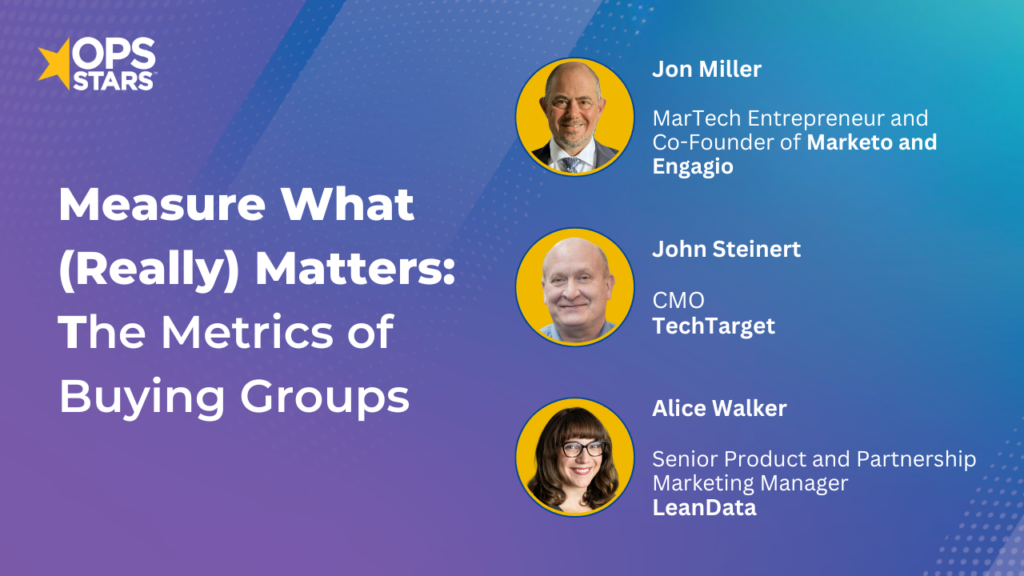The old sales model is evolving. MQLs only convert at 1%, and ABM motions don’t give you the full picture of the buying committee. Is there a new model out there that can increase conversions, reduce sales cycles, and provide an overall better buying experience?
In this webinar LeanData CEO, Evan Liang, and CMO, Jim Bell, discuss:
- The need for a new B2B marketing model
- How to increase win rates while decreasing sales velocity
- Why companies are switching to Buying Groups
Stop selling the way you want to sell. Start selling the way your buyers want to buy. Discover how Palo Alto Networks successfully implemented the Buying Groups strategy, and why it might be the right approach for your business, too.
If you’re considering adopting Buying Groups, another valuable resource is the “Measure What (Really) Matters: The Metrics of Buying Groups” session from OpsStars 2024, where Jon Miller, MarTech entrepreneur and Co-Founder of Marketo and Engagio, and John Steinert, Chief Marketing Officer at TechTarget, explained the key data required to launch this new opportunity-centric approach. They also covered how these metrics can guide targeting and foster alignment between sales and marketing.
Webinar Transcript
Alice Walker 01:44
Hello, and thank you for joining us for LeanData’s Selling the Way the Business Buys. We’re here to talk about buying groups. My name is Alice Walker, and I’m a Senior Product and Partner Manager at LeanData. Over the past couple of years, we’ve been passionate about helping clients understand and implement buying groups. Our goal today is to discuss what buying groups are, why they’re essential, and—most importantly—how to make them actionable.
With me are our CEO, Evan Liang, and our new CMO, Jim Bell. Jim’s new to the organization but has already made an impact. The three of us are here to discuss buying groups and their potential impact on your organization. Evan, would you like to give us a quick overview of LeanData’s experience with buying groups?
Evan Liang 03:12
Absolutely, Alice. Thanks for the introduction. LeanData has worked with thousands of companies over the past 10 years, helping them operationalize their go-to-market strategy, whether that’s a lead-based model, an account-based model, or increasingly, a buying groups model. We’ve been fortunate to partner with large enterprises that have been early adopters of these new go-to-market strategies.
We were there for the transition from lead-based to account-based models and helped companies execute their ABM strategies by aligning data, processes, and people. Now, we’re seeing top customers adopt buying groups, and we’re helping them navigate the challenges and pain points of this new approach. Think of LeanData as your trusted partner in executing go-to-market plans.
Alice Walker 04:33
Thank you, Evan. Before we dive in, I’d like to cover a few housekeeping items. Feel free to submit questions in the Q&A section—we’ll have time for those at the end. This session is being recorded, and we’ll send it out afterward.
To kick things off, we’re curious about where our audience stands with buying groups. Let’s start with a quick poll to see how familiar you are with the concept. Are you considering it? Already working on it? Just here to learn? Let us know.
Evan Liang 06:30
Let’s start by talking about the evolution that led us to buying groups. Back in the late ’90s and early 2000s, SiriusDecisions introduced the MQL and the revenue waterfall. This helped bridge marketing and sales through lead-based processes. About a decade later, in the 2010s, companies began recognizing the limitations of MQLs. The notion of Account-Based Marketing (ABM) emerged to address these gaps by focusing on target accounts, aligning sales and marketing toward common goals.
As the complexity of B2B sales grew, companies began realizing it wasn’t enough to focus on target accounts. Many organizations are multinational with multiple SKUs and product lines, so they needed to focus on buying groups and opportunities within accounts. This shift means sales is no longer just about engaging individuals; it’s about engaging a well-defined buying committee. Today, companies that adopt this approach are better aligned with how B2B buying happens, and that’s what makes this evolution so powerful.
Alice Walker 09:18
It’s like technology is finally catching up with how B2B sales have been happening for a while. That brings us to Jim—what’s your perspective on buying groups from a marketing alignment standpoint?
Jim Bell 10:19
Great question, Alice. The simplest way to explain buying groups is that it’s what top B2B account executives have always done: they build relationships with all stakeholders involved in the buying process. By operationalizing this, we can lift the performance of the entire sales team, not just our top reps.
Marketing has been on a parallel journey, from MQLs and funnel models to ABM. Traditionally, once an opportunity is created, marketing steps back to avoid overwhelming the account. But with buying groups, marketing can maintain engagement with all key stakeholders, not just leads or accounts. This approach aligns marketing more closely with sales objectives, helping us to target personas we may not have engaged before, thereby improving win rates.
Alice Walker 15:12
Thank you, Jim. Now that we’ve set the context, let’s talk about the practical challenges of moving to a buying groups model. Evan, from a data and technology perspective, what are some obstacles companies face?
Evan Liang 16:39
Change management is the biggest hurdle. Many companies struggle with aligning data and technology in ways that minimize disruptions for sales reps. Buying groups require that CRM structures, like the opportunity contact role, are fully leveraged, which traditionally hasn’t been the case. Today’s technology allows us to automate processes without requiring reps to do extra work, and we’re seeing clients adopt methods like creating “$0 opportunities” to allow marketing access without interfering with sales.
Another challenge is tracking performance. New metrics are essential to measure the effectiveness of buying groups, from opportunity completion rates to engagement metrics. Seamless data alignment and a low-friction user experience for frontline teams are key to a successful buying groups implementation.
Alice Walker 24:03
It sounds like there are many ways to implement buying groups, depending on the organization’s unique processes and systems. When a company fully adopts this model, what kind of results can they expect?
Evan Liang 24:53
Our clients, like Palo Alto Networks, have seen significant benefits, including a 2x increase in win rates, higher pipeline progression, and improved revenue. Contrary to some fears, adding more people to buying groups actually accelerates deals by reducing the likelihood of last-minute surprises. Siemens is another example—they’ve been pioneers in this area and are still progressing on their buying groups journey.
Alice Walker 26:32
That’s exciting. To break it down for everyone, we’ve identified four key phases in adopting buying groups: align, build, orchestrate, and measure. Evan, how can companies get started?
Evan Liang 29:50
LeanData recently launched two products to address these challenges. First, Blueprint helps companies analyze historical data to build a business case for buying groups. Orchestrator, on the other hand, enables organizations further along the journey to operationalize and automate their buying groups processes. These products reflect our commitment to being a trusted partner for companies at every stage of their buying groups journey.
Jim Bell 31:35
To add, on the marketing side, Orchestrator helps ensure consistent engagement across all key personas, creating awareness among stakeholders like finance or IT, who may not typically be involved early on. This kind of alignment is crucial for a successful buying groups motion.
Alice Walker 32:47
Thanks, Jim and Evan. If anyone is interested in learning more, please reach out, and we’ll be happy to provide more information. Let’s move to the Q&A. First question: How long does it typically take to see results with buying groups?
Evan Liang 33:56
It depends on the company size. Some companies see quick wins with smaller pilots, while larger organizations may require a multi-year effort. However, with a phased approach, results don’t have to take long.
Alice Walker 34:46
Thank you. Next question: What metrics should marketing be measured on in a buying groups model?
Jim Bell 35:14
In addition to MQLs, marketing can track metrics like buying group completion rates and pipeline progression. It’s about moving from individual leads to tracking holistic engagement across all key roles in a buying group.
Evan Liang 37:22
Great points. Don’t abandon MQLs; instead, use them alongside buying group metrics. Start by tracking opportunities with at least three members in a buying group and monitor win rates compared to single-member opportunities.
Alice Walker 38:20
And finally, how can you get executive buy-in for buying groups?
Evan Liang 39:24
Start with the macro trends—show how buying behavior has changed and why current models are insufficient. Highlight customer examples and consider piloting with quick wins to build momentum.
Alice Walker 42:49
Thank you to Evan, Jim, and all of you who joined us. If you’re interested in more resources, join our Buying Groups Leaders LinkedIn group and check out our follow-up materials. Have a great day!











